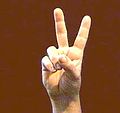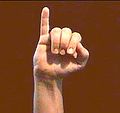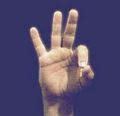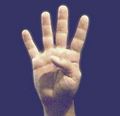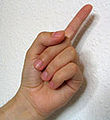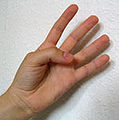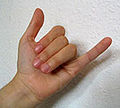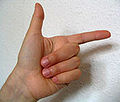- Finger binary
-
Finger binary is a system for counting and displaying binary numbers on the fingers and thumbs of one or more hands. It is possible to count from 0 to 31 (25−1) using the fingers of a single hand, or from 0 through 1023 (210−1) if both hands are used.
Contents
Mechanics
In the binary number system, each numerical digit has two possible states (0 or 1) and each successive digit represents an increasing power of two. The rightmost digit represents two to the zeroth power (i.e., it is the "ones digit"); the digit to its left represents two to the first power (the "twos digit"); the next digit to the left represents two to the second power (the "fours digit"); and so on. (The decimal number system is essentially the same, only that powers of ten are used: "ones digit", "tens digit" "hundreds digit", etc.)
It is possible to use anatomical digits to represent numerical digits by using a raised finger to represent a binary digit in the "1" state and a lowered finger to represent it in the "0" state. Each successive finger represents a higher power of two. With palms oriented toward the counter's face, the values are:
Pinky Ring Middle Index Thumb Power of two 24 23 22 21 20 Value 16 8 4 2 1 if only the right hand is used, and:
Left hand Right hand Thumb Index Middle Ring Pinky Pinky Ring Middle Index Thumb Power of two 29 28 27 26 25 24 23 22 21 20 Value 512 256 128 64 32 16 8 4 2 1 if both hands are used.
The values of each raised finger are added together to arrive at a total number. In the one-handed version, all fingers raised is thus 31 (16 + 8 + 4 + 2 + 1), and all fingers lowered (a fist) is 0. In the two-handed system, all fingers raised is 1,023 (512 + 256 + 128 + 64 + 32 + 16 + 8 + 4 + 2 + 1) and two fists (no fingers raised) represents 0.
It is also possible to have each hand represent an independent number between 0 and 31; this can be used to represent various types of paired numbers, such as month and day, X-Y coordinates, or sports scores (such as for table tennis or baseball).
Examples
Negative numbers and non-integers
Just as fractional and negative numbers can be represented in binary, they can be represented in finger binary.
Negative numbers
Representing negative numbers is extremely simple, by using the leftmost finger as a sign bit: raised means the number is negative, in a sign-magnitude system. Anywhere between -511 and +511 can be represented this way, using two hands. Note that, in this system, both a positive and a negative zero may be represented.
If a convention were reached on palm up/palm down representing positive/negative, you could maintain 2^10 - 1 in both positive and negative numbers (-1023 to +1023, with positive and negative zero still represented).
Fractions
There are multiple ways of representing fractions in finger binary.
Dyadic fractions
Fractions can be stored natively in a binary format by having each finger represent a fractional power of two:
 . (These are known as dyadic fractions.)
. (These are known as dyadic fractions.)Using the left hand only:
Thumb Index Middle Ring Pinky Value 1/2 1/4 1/8 1/16 1/32 Using two hands:
Left Hand Right Hand Thumb Index Middle Ring Pinky Pinky Ring Middle Index Thumb 1/2 1/4 1/8 1/16 1/32 1/64 1/128 1/256 1/512 1/1024  3/4, in fractional finger binary
3/4, in fractional finger binary
The total is calculated by adding all the values in the same way as regular (non-fractional) finger binary, then dividing by the largest fractional power being used (32 for one-handed fractional binary, 1024 for two-handed), and simplifying the fraction as necessary.
For example, with thumb and index finger raised on the left hand and no fingers raised on the right hand, this is (512 + 256)/1024 = 768/1024 = 3/4. If using only one hand (left or right), it would be (16 + 8)/32 = 24/32 = 3/4 also.
The simplification process can itself be greatly simplified by performing a bit shift operation: all digits to the right of the rightmost raised finger (i.e., all trailing zeros) are discarded and the rightmost raised finger is treated as the ones digit. The digits are added together using their now-shifted values to determine the numerator and the rightmost finger's original value is used to determine the denominator.
For instance, if the thumb and index finger on the left hand are the only raised digits, the rightmost raised finger (the index finger) becomes "1". The thumb, to its immediate right, is now the 2s digit; added together, they equal 3. The index finger's original value (1/4) determines the denominator: the result is 3/4.
Rational numbers
Combined integer and fractional values (i.e., rational numbers) can be represented by setting a radix point somewhere between two fingers (for instance, between the left and right pinkies). All digits to the left of the radix point are integers; those to the right are fractional.
Decimal fractions and vulgar fractions
Dyadic fractions, explained above, unfortunately have limited use in a society based around decimal figures. A simple non-dyadic fraction such as 1/3 can be approximated as 341/1024 (0.3330078125), but the conversion between dyadic and decimal (0.333) or vulgar (1/3) forms is complicated.
Instead, either decimal or vulgar fractions can be represented natively in finger binary. Decimal fractions can be represented by using regular integer binary methods and dividing the result by 10, 100, 1000, or some other power of ten. Numbers between 0 and 102.3, 10.23, 1.023, etc. can be represented this way, in increments of 0.1, 0.01, 0.001, etc.
Vulgar fractions can be represented by using one hand to represent the numerator and one hand to represent the denominator; a spectrum of rational numbers can be represented this way, ranging from 1/31 to 31/1 (as well as 0).
Finger ternary
In theory, it is possible to use other positions of the fingers to represent more than two states (0 and 1); for instance, a ternary numeral system (base 3) could be used by having a fully raised finger represent 2, fully lowered represent 0, and "curled" (half-lowered) represent 1. This would make it possible to count up to 59,048 (310−1) on two hands. In practice, however, many people will find it difficult to hold all fingers independently (especially the middle and ring fingers) in more than two distinct positions.
See also
References
- Pohl, Frederik (2003). Chasing Science (reprint, illustrated ed.). Macmillan. pp. 304. ISBN 9780765308290. http://books.google.com/books?id=XsLXJMagfmUC&pg=PA187&dq=fingers+binary+1023#PPA187,M1.
- Pohl, Frederik (1976). The Best of Frederik Pohl. Sidgwick & Jackson. pp. 363. http://books.google.com/books?id=fDxbAAAAMAAJ&q=fingers+binary+1023&dq=fingers+binary+1023&pgis=1.
- Fahnestock, James D. (1959). Computers and how They Work. Ziff-Davis Pub. Co.. pp. 228. http://books.google.com/books?id=j_0mAAAAMAAJ&q=fingers+binary+1023&dq=fingers+binary+1023&pgis=1.
External links
Gestures Friendly gestures Air kiss · A-ok · Cheek kissing · Dap greeting · Elbow bump · Eskimo kissing · Fist bump · Hat tip · High five · Hongi · ILY sign · Namaste · Sign of the horns · Shaka · Thumbs signal · WaiFormal gestures Salutes Bellamy salute · Nazi salute · Raised fist · Roman salute · Scout sign and salute · Three-finger salute · Two-finger salute · Vulcan salute · Zogist saluteCelebratory gestures Finger counting Obscene gestures Head motions Other gestures Air quotes · Anasyrma · Crossed fingers · Facepalm · Finger gun · Gang signal · Hand-rubbing · Jazz hands · Kuji-in · Laban sign · Loser · Mudra · Pollice verso · Puppy face · Shrug · Sign of the Cross · Varadamudra · V signRelated Categories:
Wikimedia Foundation. 2010.



